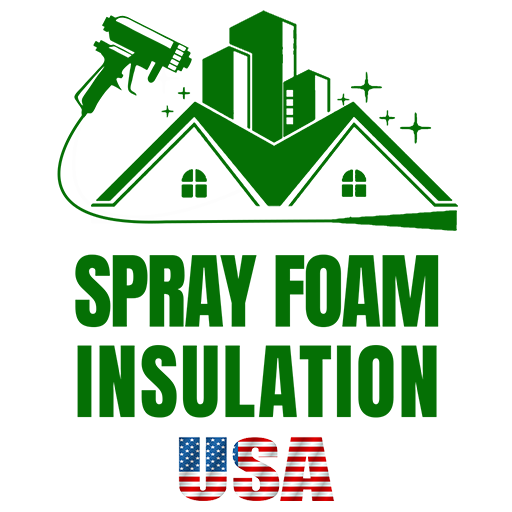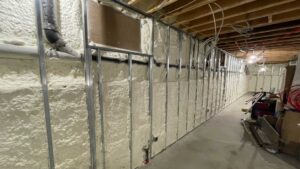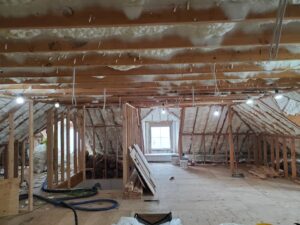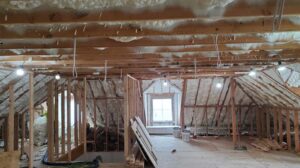When you’re on the hunt for insulation solutions, the term R-Value is likely to pop up frequently. It’s a critical number that tells you how well insulation resists heat flow. Basically, the higher the R-Value, the better the material keeps your space warm in winter and cool in summer.
For those seeking a quick answer on spray foam insulation R-Value:
– Closed-Cell Spray Foam: High R-Value, around 6.5 – 7 per inch, offering excellent moisture resistance and density.
– Open-Cell Spray Foam: Lower R-Value, about 3.8 per inch, more cost-effective with good vapor permeability.
Understanding R-Value significance is straightforward: It’s about energy efficiency. Better insulation means your heating and cooling systems work less, reducing energy bills and enhancing comfort inside your home or business.
Let’s keep it really simple. The chase for quality insulation comes down to two things: keeping warmth where you want it and cutting down on energy bills. Spray foam insulation, with its superior R-Value, happens to be a top contender for both. Whether opting for the denser closed-cell or the more breathable open-cell foam, you’re investing in your property’s comfort and efficiency.

Understanding R-Value in Insulation
When we talk about keeping our homes comfortable and energy-efficient, the term “R-Value” comes up a lot. But what is it, and why does it matter? Let’s break it down in simple terms.
Thermal Resistance
At its core, R-Value measures how well an insulation material can resist heat flow. Think of it like a superhero’s shield against heat. The higher the R-Value, the stronger the shield. This means less heat escapes your home in the winter and less heat enters during the summer.
[Heat Flow](https://en.wikipedia.org/wiki/R-value_(insulation)
Heat moves in three ways: conduction, convection, and radiation. Insulation’s main job is to slow down this movement, especially conduction – the way heat travels through materials. Imagine a hot cup of coffee; if you touch the cup, you feel heat because it’s conducted from the coffee to the cup to your hand.
Conductive Flow
Conductive flow is all about heat moving through solid materials, like the walls of your house. Here’s where R-Value shines. Materials with a high R-Value are like a thick winter coat for your home. They keep the warm air inside from escaping and prevent cold air outside from getting in.
Spray Foam Insulation R-Value
Spray foam insulation is a star player in the insulation game because of its high R-Value. It provides a powerful barrier against conductive heat flow. This means it’s incredibly effective at keeping your home’s temperature stable, no matter what the weather outside is doing.
-
Closed-Cell Spray Foam: This type has a higher R-Value per inch than open-cell, making it a heavyweight champion in resisting heat flow. It’s dense, moisture-resistant, and adds structural strength to your walls.
-
Open-Cell Spray Foam: While it has a lower R-Value per inch compared to closed-cell, it’s more cost-effective and great at blocking air movement. This makes it an excellent choice for keeping your home comfortable and reducing energy bills.
Why It Matters
Understanding R-Value is crucial because it helps you choose the right insulation for your home. The right R-Value can mean the difference between a cozy, energy-efficient home and one that’s always too hot or too cold.
In short, when considering spray foam insulation, its R-Value is your home’s shield against energy loss. Whether you go with closed-cell or open-cell, you’re making a smart move towards a more comfortable, efficient home.
And remember, the goal is not just to pick any insulation but to choose one with the right R-Value for your specific needs. That’s how you maximize comfort and minimize energy bills.
Next, we’ll dive into the factors affecting spray foam insulation’s R-Value and how it compares to other types of insulation.

Types of Spray Foam Insulation and Their R-Values
When it comes to keeping your home cozy and your energy bills low, not all insulation is created equal. Spray foam insulation stands out for its exceptional ability to resist heat flow, thanks to its impressive R-value. But what exactly does this mean, and how do the two main types of spray foam insulation compare? Let’s break it down into bite-sized pieces.
Closed-Cell Spray Foam Insulation
Imagine wrapping your home in a thick, warm blanket that keeps the cold out and the warmth in. That’s essentially what closed-cell spray foam insulation does. It’s like the superhero of insulation, boasting a high R-value of about R-6.5-7 per inch. This means it has a strong resistance to heat flow, making it a top choice for those looking to maximize energy efficiency.
But it’s not just about keeping warm. Closed-cell foam is dense and acts as a moisture barrier. This is crucial because it helps prevent water vapor from seeping into your walls, which can cause mold and mildew. So, not only does it keep your home warm, but it also keeps it dry and healthy.
Open-Cell Spray Foam Insulation
Now, let’s talk about open-cell spray foam insulation. Think of it as the friendly neighbor of closed-cell foam. It has a lower R-value, around R-3.5 to R-3.6 per inch, but don’t let that fool you. It’s still an effective insulator and comes with its own set of benefits.
Open-cell foam is lighter and more flexible than its closed-cell counterpart. It’s like a sponge, able to absorb sound and reduce noise. This makes it a great option for insulating interior walls, where noise reduction is a priority. Plus, it’s generally more cost-effective, making it a solid choice for larger projects where budget is a concern.
Vapor Permeability is another key feature of open-cell foam. Unlike closed-cell foam, it allows moisture to pass through, which can be advantageous in certain climates and building designs. This feature helps maintain a balanced moisture level within the walls, preventing the buildup of moisture.
Making the Choice
Choosing between closed-cell and open-cell spray foam insulation comes down to your specific needs. If you’re looking for the highest R-value and moisture resistance, closed-cell is the way to go. It’s ideal for exterior walls, roofs, and areas prone to moisture.
On the other hand, if cost-effectiveness and sound absorption are your priorities, open-cell foam is a smart choice. It’s perfect for interior walls and spaces where moisture permeability can be beneficial.
Both types of spray foam insulation offer significant energy savings by creating an effective air seal, which traditional insulations like fiberglass and cellulose struggle to match. This air seal minimizes the energy needed to heat or cool your home, leading to lower utility bills and a more comfortable living environment.
In summary, the right type of spray foam insulation for you depends on your project’s specific requirements. Whether you choose closed-cell for its high R-value and moisture resistance or open-cell for its cost-effectiveness and sound-dampening properties, you’re making a smart investment in your home’s comfort and efficiency.
Stay tuned as we explore how spray foam insulation’s R-value compares to other types of insulation, ensuring you have all the information you need to make the best choice for your home.
Factors Affecting Spray Foam Insulation’s R-Value
When it comes to enhancing your home’s energy efficiency, understanding the factors that affect the R-value of spray foam insulation is crucial. Let’s dive into the key elements: the age of the foam, its type, and its moisture permeability.
Age of the Foam
Over time, the R-value of spray foam insulation can change. However, it’s good news with spray foam: as it ages, its R-value remains relatively stable. Unlike other insulation materials that might settle or degrade, reducing their effectiveness, spray foam holds its own. This stability is a big plus, ensuring that the energy-saving benefits last for the long haul.
Type of Foam
There are two main types of spray foam insulation: open-cell and closed-cell. Each has its own set of benefits and, importantly, its own R-value.
-
Closed-Cell Spray Foam Insulation: This type is denser and has a higher R-value, typically between R-6 to R-7 per inch. It’s also moisture impermeable, making it an excellent choice for areas prone to dampness.
-
Open-Cell Spray Foam Insulation: Lighter and more flexible, open-cell foam has an R-value of about R-3.6 to R-3.9 per inch. It’s vapor permeable, which can be beneficial for certain applications, though it means it’s not as resistant to water as closed-cell foam.
Moisture Permeability
Moisture can impact the R-value of insulation. For open-cell foam, which is moisture permeable, water intrusion can lower its R-value, as water conducts heat more efficiently than air. Closed-cell foam, on the other hand, resists moisture, maintaining its R-value even in damp conditions. This makes closed-cell foam a robust option for ensuring long-term energy efficiency, regardless of environmental factors.
Understanding these factors can help you make a more informed decision about which spray foam insulation is right for your home. Whether you lean towards closed-cell for its high R-value and moisture resistance or open-cell for its cost-effectiveness and breathability, you’re enhancing your home’s energy efficiency.
Next, we’ll compare the R-value of spray foam insulation to other materials like fiberglass and cellulose. This will give you a clearer picture of how spray foam stands out in insulation.
Comparing Spray Foam Insulation R-Value to Other Insulations
When choosing the right insulation for your home, understanding how spray foam insulation measures up against other types is crucial. Let’s dive into the specifics:
Spray Foam vs. Fiberglass
Air Seal: Spray foam insulation excels in creating an air-tight seal. Unlike fiberglass, which allows air to flow through its fibers, spray foam fills up cracks and gaps, leaving no room for air leakage. This air seal is vital for preventing energy loss.
Thermal Bridging: Fiberglass insulation is often interrupted by wooden frames and other materials in the structure of a building, a phenomenon known as thermal bridging. Spray foam insulation, however, can be applied continuously over areas that would otherwise be prone to thermal bridging, offering superior protection against heat loss.
Spray Foam vs. Cellulose
Conduction and Convection: Both spray foam and cellulose insulations provide resistance to heat conduction. However, the ability of spray foam to stop air movement (convection) is where it really shines. Cellulose, being a fibrous material, cannot prevent air from moving through it as effectively as spray foam can, making spray foam the more efficient option in terms of overall thermal resistance.
Air Movement: The open spaces within cellulose insulation allow for air movement, which can lead to energy loss. Spray foam’s expansive nature allows it to fill these spaces, effectively stopping air movement and enhancing the insulation’s overall performance.
Spray Foam vs. Polyisocyanurate
Highest R-Value: Polyisocyanurate (polyiso) is known for its high R-value per inch, making it a strong competitor against spray foam. However, when considering the ability to create an air seal and prevent thermal bridging, spray foam often provides a more comprehensive insulation solution.
Radiant Barrier: Polyiso is often used for its reflective properties, acting as a radiant barrier. However, spray foam insulation’s ability to seal gaps, prevent air movement, and provide high R-values makes it a more versatile option, capable of meeting a wider range of insulation needs.
In conclusion, while fiberglass, cellulose, and polyisocyanurate each have their advantages, spray foam insulation stands out for its ability to create an air seal, prevent thermal bridging, and offer superior resistance to both conduction and convection. This makes it an excellent choice for homeowners looking to maximize their home’s energy efficiency. Whether you’re in a cold or warm climate, understanding the unique benefits of spray foam insulation can help you make an informed decision for your insulation needs.
Next, we’ll explore how maximizing home efficiency with spray foam insulation can lead to significant energy savings and contribute to a more comfortable living environment.
Maximizing Home Efficiency with Spray Foam Insulation
When it comes to insulating your home, creating an air seal is arguably as important as the insulation itself. This is where spray foam insulation shines. Unlike traditional insulation materials that merely slow down the passage of heat, spray foam creates a comprehensive barrier against air movement. This means fewer drafts, less unwanted air infiltration, and ultimately, a more consistent indoor temperature.
Energy Savings are a direct benefit of this air seal. When air isn’t freely flowing in and out of your home, your heating and cooling systems don’t have to work as hard to maintain a comfortable environment. This reduction in energy demand can lead to noticeable savings on your utility bills. In fact, homeowners have reported up to a 50% reduction in energy costs after installing spray foam insulation. This isn’t just good for your wallet; it’s good for the planet too. Lower energy consumption means fewer carbon emissions.
But not all homes are created equal, and neither are all climates. This is where Climate Zones come into play. The United States is divided into several climate zones, each with its own set of recommendations for insulation R-values. Spray foam’s high R-value per inch makes it an excellent choice for any zone, whether you’re dealing with the humid heat of the South or the biting cold of the North. Because it provides both an air seal and high R-value insulation, spray foam can be tailored to meet the specific needs of your climate zone, ensuring your home is as energy-efficient as possible.
In summary, maximizing home efficiency with spray foam insulation comes down to leveraging its ability to create an effective air seal, which in turn leads to significant energy savings. No matter your climate zone, spray foam provides a versatile and powerful solution to keep your home comfortable and your energy costs low. This is not just an investment in your home; it’s an investment in a sustainable future.
Remember that choosing the right insulation for your home is about more than just numbers on a spec sheet. It’s about creating a comfortable, energy-efficient space for you and your family.
Frequently Asked Questions about Spray Foam Insulation R-Value
When it comes to insulation, spray foam is a standout for its efficiency and effectiveness. Let’s dive into some of the most common questions about spray foam insulation R-value to help you understand why.
What is the R-value of 2 inches of spray foam?
The R-value of 2 inches of spray foam can vary depending on whether you’re using open-cell or closed-cell spray foam. Closed-cell spray foam has a higher R-value, typically around R-6 to R-7 per inch, so 2 inches would have an R-value of R-12 to R-14. On the other hand, open-cell spray foam has a lower R-value, around R-3.6 to R-3.9 per inch, so 2 inches would provide an R-value of R-7.2 to R-7.8.
How does the R-value of spray foam compare to fiberglass?
Spray foam insulation often has a higher R-value per inch than fiberglass. While fiberglass insulation typically has an R-value of R-2.2 to R-4.0 per inch, closed-cell spray foam can reach up to R-7 per inch. This means spray foam can provide more thermal resistance with less thickness. Additionally, spray foam creates an air seal that fiberglass cannot, reducing air leaks and enhancing the overall efficiency of your home’s insulation.
Can spray foam insulation’s R-value decrease over time?
One of the benefits of spray foam insulation is its durability and stability over time. While some insulation materials can settle or degrade, affecting their R-value, high-quality spray foam insulation is designed to maintain its R-value for the lifespan of your home. This is due to its ability to resist moisture and not settle or degrade. However, it’s crucial to choose a reputable product and ensure it’s installed correctly to guarantee its long-term performance.
The right insulation can make a significant difference in your home’s energy efficiency and comfort. Spray foam insulation, with its high R-value and air sealing capabilities, is an excellent choice for those looking to upgrade their home’s insulation.
Let’s explore the sustainable solutions and eco-friendly insulation options offered by Spray Foam Insulation USA, ensuring your home is not only comfortable but also contributes to a healthier planet.
Conclusion
In wrapping up our comprehensive guide on the spray foam insulation R-value, it’s clear that choosing the right insulation plays a pivotal role in enhancing your home’s energy efficiency and comfort. At Spray Foam Insulation USA, we are committed to providing you with insulation solutions that not only meet your needs but also align with our vision for a sustainable and eco-friendly future.
Sustainable Solutions
Our approach to insulation goes beyond just filling in the gaps. We understand the importance of using products that have a minimal environmental footprint. That’s why our spray foam insulation is designed to last longer, reducing the need for replacements and, consequently, the waste generated over time. By choosing spray foam insulation, you’re not just investing in your home’s comfort and efficiency; you’re also making a choice that benefits the environment.
Eco-Friendly Insulation
We take pride in offering eco-friendly insulation options that contribute to healthier living spaces and a healthier planet. Our spray foam products are crafted to reduce energy consumption significantly. By creating an effective air seal, they minimize the carbon footprint of heating and cooling systems, leading to lower greenhouse gas emissions. Moreover, our commitment to eco-friendliness is reflected in our careful selection of materials that are less harmful to the environment.
At Spray Foam Insulation USA, we believe that making your home more energy-efficient shouldn’t come at the expense of the planet. Our solutions are designed to provide the best of both worlds – exceptional insulation performance with a high R-value and a commitment to sustainability.
Whether you’re looking to insulate a new build or enhance the efficiency of an existing structure, we have the expertise and the eco-friendly solutions to help you achieve your goals. Explore our range of services and discover how we can transform your space into a more comfortable, energy-efficient, and environmentally friendly home.
Ready to make a difference in your home and for the planet? Contact us today for a free estimate and take the first step towards a more sustainable and comfortable living environment.





